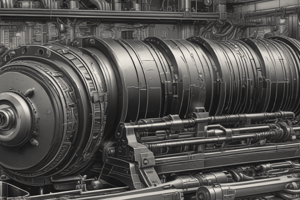Podcast
Questions and Answers
What is a lathe used for?
What is a lathe used for?
- Cutting, sanding, drilling, knurling, or deforming metal or wood (correct)
- Sewing and embroidery work
- Mixing, blending, and shaping clay
- Assembling electronic components
Difference between natural draught & artificial draught
Difference between natural draught & artificial draught
Which part of a lathe holds and rotates the workpiece?
Which part of a lathe holds and rotates the workpiece?
- Chuck (correct)
- Tailstock
- Apron
- Carriage
What is the purpose of a lathe's tailstock?
What is the purpose of a lathe's tailstock?
What are the main components of a lathe?
What are the main components of a lathe?
Explain the difference between a center lathe and an engine lathe.
Explain the difference between a center lathe and an engine lathe.
How does a lathe contribute to the process of metalworking?
How does a lathe contribute to the process of metalworking?
Flashcards
What is a lathe?
What is a lathe?
A machine tool used for cutting, sanding, drilling, knurling, or deforming metal or wood.
What is a chuck?
What is a chuck?
Holds and rotates the workpiece during lathe operations.
What does a tailstock do?
What does a tailstock do?
Supports the end of the workpiece, providing stability during machining.
Lathe main components?
Lathe main components?
Signup and view all the flashcards
Lathe in metalworking?
Lathe in metalworking?
Signup and view all the flashcards
Center vs Engine lathe?
Center vs Engine lathe?
Signup and view all the flashcards
Study Notes
Lathe Overview
- A lathe is a machine used for woodworking, metalworking, and glassworking to create symmetrical objects.
Lathe Components
- A lathe consists of a bed, headstock, tailstock, and tool rest.
- The headstock holds and rotates the workpiece.
- The tailstock provides additional support and holds the workpiece in place.
Lathe Types
- A center lathe is a general-purpose lathe used for most turning operations.
- An engine lathe is a heavy-duty lathe used for large, heavy workpieces and high-volume production.
Draught in Lathes
- Natural draught uses natural airflow to remove chips and debris from the work area.
- Artificial draught uses a suction system or vacuum to remove chips and debris.
Lathe's Role in Metalworking
- A lathe plays a crucial role in metalworking by allowing for the creation of symmetrical objects, such as axles, shafts, and other cylindrical parts.
- Lathes enable the machining of metals with precision and accuracy.
Studying That Suits You
Use AI to generate personalized quizzes and flashcards to suit your learning preferences.




